HOW TO MAKE KOMBUCHA AT HOME
Supplies
All links open to another window.
Large pot for brewing tea - I use one like THIS.
Organic tea - Green or Black (we mostly use black and this is my favorite right now) I prefer loose tea but you can use tea bags (1 tsp loose tea = 1 tea bag). You can also use a few other teas such as oolong or white tea, but I have not personally tried those yet. Stay away from anything decaf, flavored, or with added ingredients. Plain tea is best.
Water - Some insist on distilled or filtered. I just use local tap and it turns out great. See what works best for you.
SCOBY - Stands for Symbiotic Culture of Bacteria and Yeast. Also referred to as a pellicle mat.
Some new information has come out since I started making kombucha. It used to be that you had to have a SCOBY to make kombucha and everyone thought it was that slimy mat (pellicle)....Now, it is being said that the actual SCOBY (Symbiotic Culture of Bacteria and Yeast) is the liquid...the fermented tea....and that no pellicle is actually needed. That it is actually a waste product of the culture.
Sorry if this is confusing. You can read the facebook conversation about it HERE.
I still keep a pellicle mat in the jar. However, I learned some time back to not let it get too thick. I keep it thinned to no thicker than a half inch.
I will just leave the rest of the instructions as-is (which include having a pellicle mat...sometimes referred to as a scoby). You are welcome to try to make kombucha without one. You would need a good amount of strong starter tea and it would take about 30 days for your first fermentation.
Where to get a scoby/ pellicle mat? Get one from a friend or local kombucha group or buy one online. I purchased mine online HERE and it has served me and others well ever since.
Starter Tea - You will also need a cup or two of plain (unflavored) kombucha to get things going. You should be able to get it with your initial SCOBY online or from a friend. You could also use a bottle of plain (unflavored) store bought kombucha.
Pure Cane Sugar - no substitutes like brown sugar, agave, or honey. I often use regular C&H table sugar, but here is a nice organic brand if you prefer.
Strainer Bags/ Tea Diffusers - I like these washable nut milk bags for steeping the loose leaf tea.
Large glass jar/container - It's up to you how much you want to make at once. I have a giant vessel now, but I started out with something like this one gallon jar.
Fabric and large rubber band to cover the top of jar - Muslin / basic cotton fabric or a few layers of cheesecloth is good. Some people use coffee filters. Just keep it breathable for the kombucha, yet a high enough thread count that fruit flies or other buggies can't get in.
Bottles (flip top grolsch style are best)
Funnel
Pitcher
Blender (optional)
Fresh fruit, organic herbs and spices for flavoring second fermentation
Stainless Steel Tea Infuser Mesh Strainer THESE are great for filtering out the fruit pulp when pouring a glass of kombucha.
First Fermentation (F1) Making the actual kombucha

Make Sweet Tea:
Bring water to a boil. Turn off heat. Cover and steep tea for about 10-15 minutes. Some say less time, some say more. ;)
Below are some general measurements to go by. I often make my tea a bit stronger than the chart says, but I do
use the basic ratio of for every ONE GALLON OF TEA add ONE CUP OF SUGAR.
There are several kombucha tea ratio charts online that can help you if you want to do small or larger batches or if you prefer to think in liters.
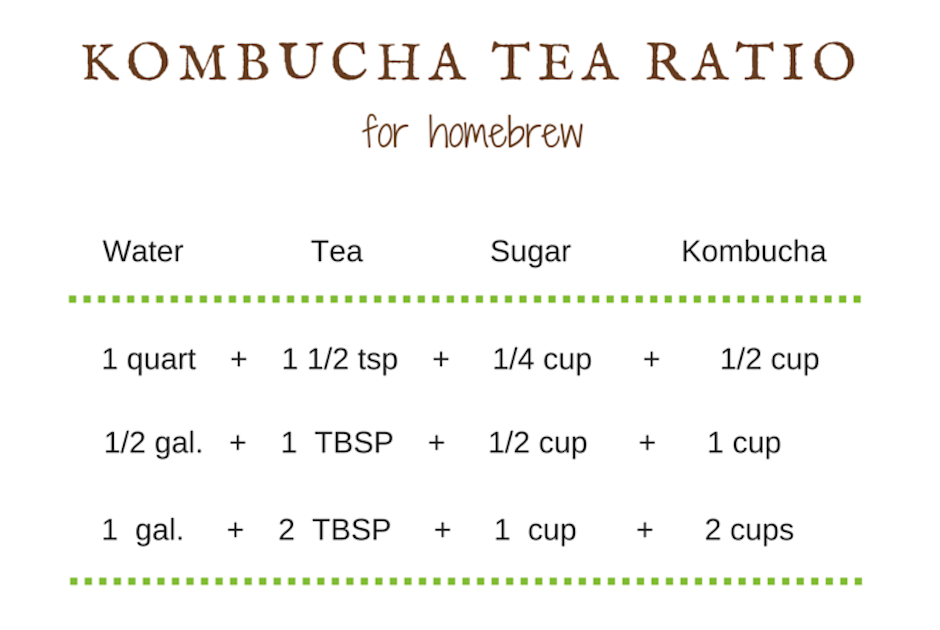
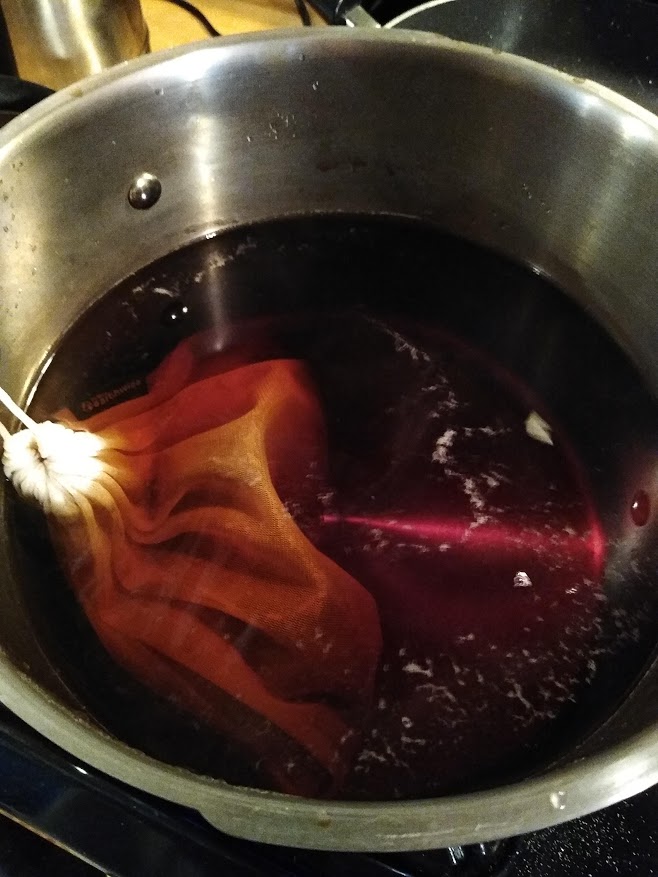
When tea is done steeping, remove tea bag or diffuser, add sugar. Stir well and let cool to room temperature.
To ferment the sweet tea, you will need some starter tea (unflavored kombucha). I know...you need kombucha to make kombucha?! Sorry, but yes.
Once you get going with this, just always save some from a previous batch. But for your first time, you will need to get its from somewhere else. Maybe where you got your SCOBY? Or you can use a bottle of plain kombucha (I hear GT is the best brand to use).
Put the SCOBY and starter tea in a clean glass jar/container.
Add cooled sweet tea and cover with a cloth and rubber band.
It doesn't matter if your SCOBY is sitting on the bottom. Leave it alone. It will float up eventually.

Now, you let it sit. I've heard it should be in a dark location, but honestly, mine's right out in the open and everything seems to work out fine. Although, our home is not very bright.
Let the tea ferment. This takes anywhere from 5-10 days depending on how warm the temperature is. The warmer it is, the faster it ferments.
I usually turn the booch over for a second fermentation every weekend. Sometimes it's ready by Friday and other times it's not ready til Sunday or early Monday. You can tell by tasting it. You want a sweet tangy taste...I like it right before it gets vinegary.
FYI It is not necessary to do a second fermentation. Some people love plain kombucha. It's up to you when to stop the fermentation and if you will flavor it.
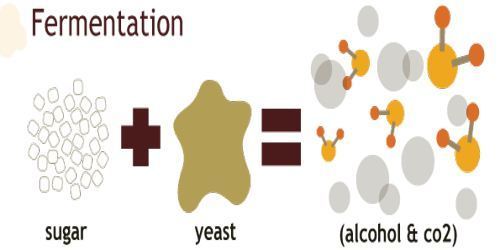
Second Fermentation (F2)

Now it's time to add fresh or frozen fruit, berries, herbs, etc. and bottle it up!
Some of our recent favorite flavorings as of late are: blueberry, blackberry, raspberry, mango, pineapple/ ginger, and lemon/ginger. I've been meaning to try strawberry/mint <3
As I said above, it's best to use fresh or frozen fruit and berries. Also, fresh grated ginger root is the bomb! You can mix and match a million flavors. A quick internet search may really inspire you.
I like to put fruit and/or berries in the blender and add a splash of kombucha. This creates a nice puree that is easy to funnel into the bottles (and easy to strain later). Small chunks of fruit are fine as well.
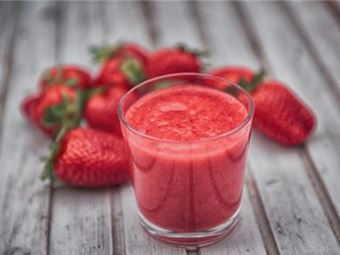
It's up to you how much fruit you want to use. I put about a half inch of puree in the bottom of each bottle.
If you are not sugar sensitive and would like a sweeter kombucha, you can add a pinch sugar (or even honey) to each bottle at this point. This, will also help with the fizz factor.
Speaking of fizz factor...It's important to give the kombucha a good stir before bottling. This really helps with carbonation.
I prefer to put the stirred up kombucha into a pitcher because it's easier for me to manage/pour.
This is my monster kombucha tank. You can see why I need a different vessel to pour with ;)
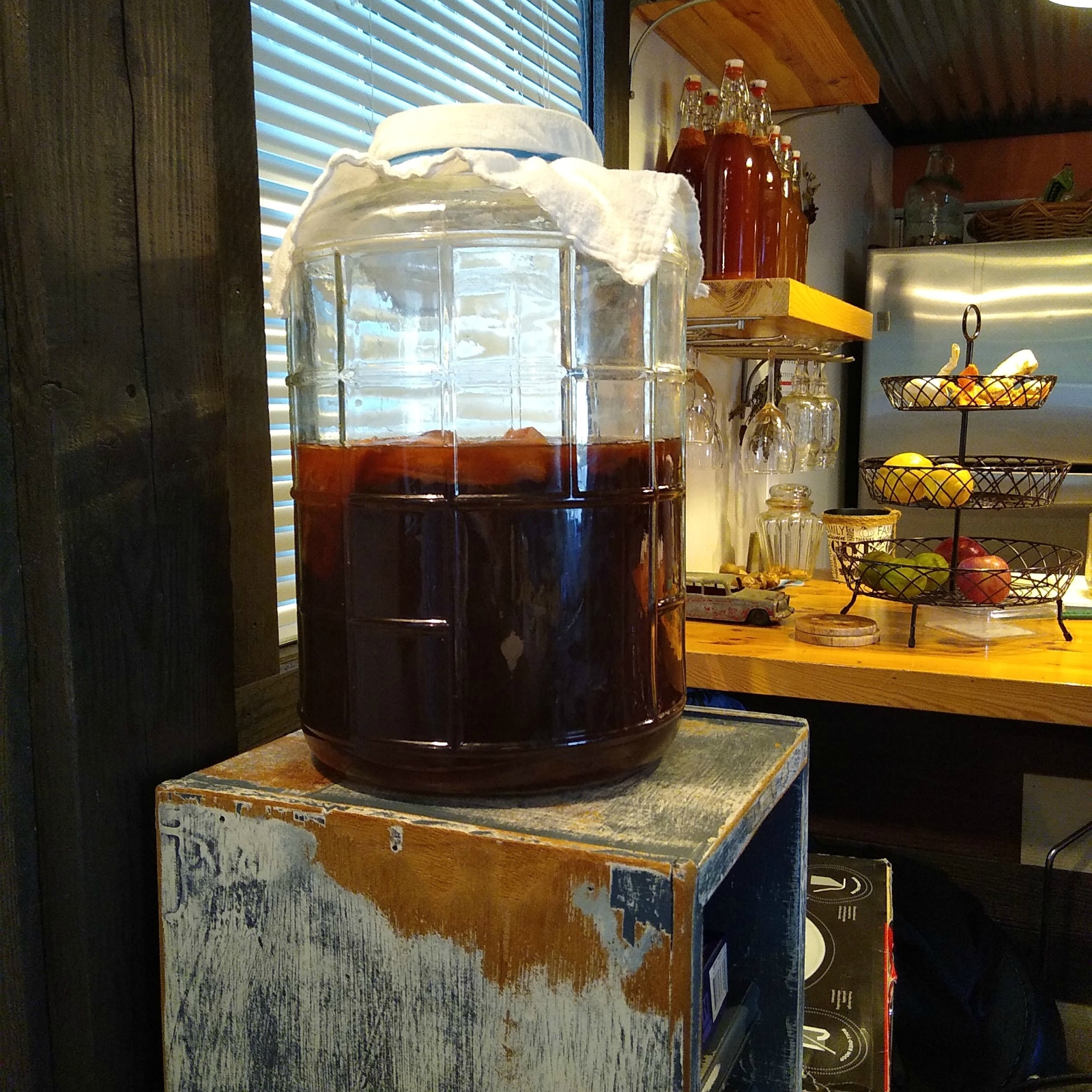
Then, using a funnel, I fill the bottles the rest of the way with kombucha and seal them shut. Do not leave a lot of air space. Maybe about a two finger width at most.
Set your bottles at room temperature for the next 3-5 days. I just put mine on a shelf, but we have had a couple explosions. Some people put theirs in a cooler or a tub/tote just in case.
.jpg?timestamp=1565054800660)
I am not totally sure how to explain when to stop the fermentation. I generally let it sit on the shelf for 3 or 4 days. Sometimes it starts fizzing and squeeking and sounding like air is escaping. That's a pretty good sign it would be fine to call it good and put them in the fridge.
You can also open a bottle and taste it. If you like it, then you are done. If it seems like the flavors have not blended or it's too sweet, let it ferment longer.
Refrigerate
Once you put your kombucha in the fridge, it stops fermenting. I suggest you chill the ready to drink bottles of kombucha in the fridge for a couple hours before giving them a try. Making them cold will not only taste best, it will also cut down on the possible kombucha explosions that can happen when opening.
Pour and enjoy!
I highly recommend you do this in the sink.
Pro tip: Get a glass and put a strainer over it. Hold the bottle aiming down at the strainer and glass as you pop the top.
A Few Extra Things To Mention
Cleanliness
This kind of goes without saying but, keep everything clean. You do not want to introduce any extra bacteria or yeasts or other microscopic critters to the process. Wash your hands. Pull your hair back. Keep the counter and utensils clean. I think of it as a bit of a science experiment and keep the work space sterile.
With that said, if you do use detergent to clean the kombucha jar or bottles...rinse, rinse, rinse! Personally, I rarely use soap on my bottles and I only washed the inside of my brewing container when I first purchased it. I just rinse bottles in very hot water and clean with a bottle brush if needed, but I don't like to add detergent unless there is a particularly stubborn situation.
Sugar
One reason I like to make my own kombucha is so I can control the sugar content. I prefer to keep it low, but...I have experimented with this and found that when I went too low, the tea did not come out well (poor taste and no fizz). The sugar is for the bacteria and yeast to feed off. If you do not add enough, they are unable to do their job creating healthy acids and carbonation.
Again, the ratio I generally stick to is: 1 cup of sugar for every 1 gallon of tea.
Honestly, I am so slack with measurements. I estimate and eyeball and it all comes out great. So, see what works for you and don't worry about being perfect.
Also, the longer you let the tea ferment, the less sugar content in the end.
Alcohol Content
Kombucha is typically considered to have a .5% alcohol content. This is such an insignificant amount, that most consider it to be a non-alcoholic beverage.
Fizz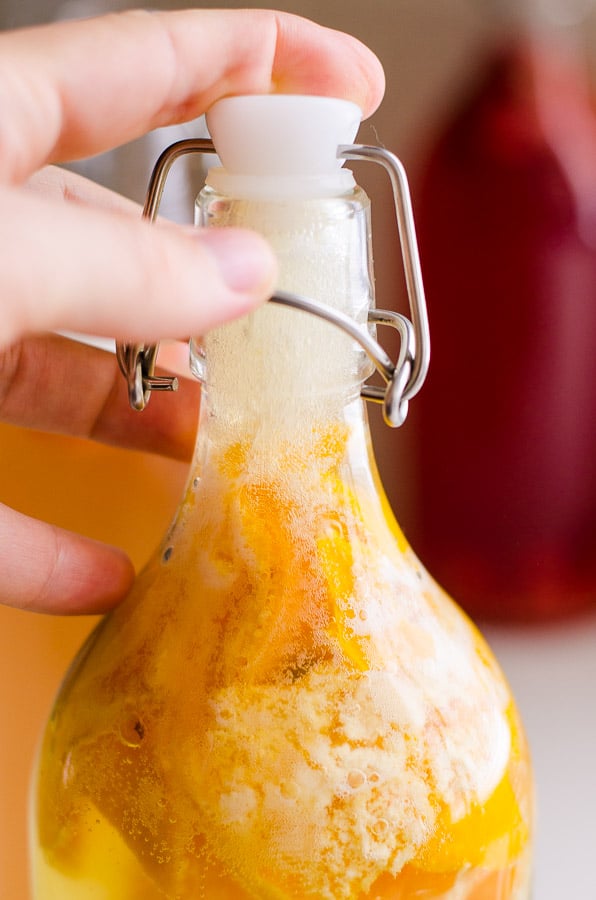
I have found the key to carbonation has to do with:
- finding that sweet spot with sugar content (too little, no fizz...too much, look out!)
- giving the kombucha a good stir before pouring into bottles for F2
- filling the bottle close to the top
- keeping tea at room temperature (some people in colder climates keep tea warm with heating pads and such)
- don't let your SCOBY get too thick...abouta half inch is good
There is plenty more to discuss about kombucha, but these instructions should get you started and on your way. You can always write me if you have questions. :)
Join our Facebook group called Kombucha For Life to ask questions, share photos, and participate in discussions.
© Copyright Kombucha For Life
